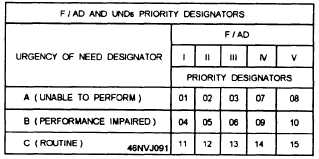designator of the requisition. It is the latest date that the
supply system is expected to make delivery of the
material to the requisitioner.
REQUISITIONER. The requisitioner can be any
Navy activity, afloat or ashore, with a unit identification
code (UIC) assigned by the NAVCOMPT Manual,
Volume 2, Chapter 5, "Requisitioning Material from a
Supply Source.”
SHIPMENT STATUS. The shipment status
pertains to positive advice of shipment and indicator of
shipment, date and mode of shipment, and
transportation control number or bill of lading number,
when applicable.
STATUS CODES. Status codes are used by supply
sources to furnish information on the status of
requisitions to the requisitioner or consignee.
100-PERCENT
SUPPLY
STATUS.
One-hundred-percent supply status relates to any
positive or negative supply distribution decision or
action at any level; that is, any action taken by the
supplier including issue of material in the exact quantity
requested.
You can see there is an extensive use of codes in
MILSTRIP requisitioning (fig. 5-8). This is necessary
because only 80 alphabetic or numeric characters
(letters and numbers) can be placed on the card (this
does not include the activity names shown in data
blocks A and B). It is essential for you to select the
correct code that conveys the proper information to the
supplier. The correct codes are just as important on a
requisition as the correct NSN.
UMMIPS
The Uniform Material Movement and Issue Priority
System (UMMIPS) is a vital and integral part of the
MILSTRIP system. MILSTRIP provides forms and
procedures for requisitioning material, and UMMIPS
provides the method of assigning priorities for issuing
and moving material.
UMMIPS ensures that material issue requests are
processed according to military IMPORTANCE and the
URGENCY of needs by the requiring activity. The
relative importance of completing demands for logistic
system resources, such as transportation, warehousing,
requisition processing, and material assets, must be
identified before material can be issued and moved.
The relative importance and urgency of logistic
requirements are indicated by two-digit issue priority
designators.
Force/Activity Designator
A Force/Activity Designator (F/AD) is a Roman
numeral (I through V) that identifies and categorizes a
force or activity on the basis of its military importance.
The assignment of an F/AD is shown in NAVSUP
P-485.
Urgency of Need Designator
The Urgency of Need Designator (UND) is an
uppercase letter of the alphabet (A, B, or C) selected to
indicate the relative urgency of a force or need of an
activity for a required item of material. The assignment
of an UND is the responsibility of the force or activity
that requires the material.
UND
Definition
A.
Requirement is immediate.
Without the material needed, the activity is
unable to perform one or more of its primary
missions.
B.
Requirement is immediate, or it is known
that such requirement will occur in the
immediate future.
The ability of the activity to perform one or
more of its primary missions is impaired
until the material is received.
C.
Requirement is routine.
Issue Priority Designator
An Issue Priority Designator (IPD) is a two-digit
number (01 highest to 15 lowest). You can determine
an IPD by using the table of priority designators (table
5-2).
Table 5-2.—F/AD and UND Priority Designators
5-15



